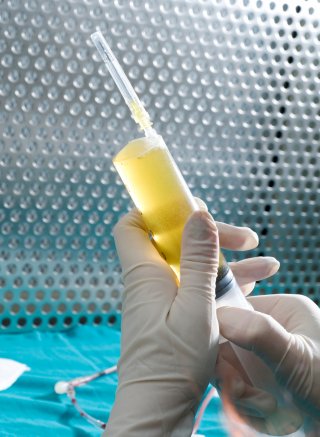
In vitro Fertilization (IVF), which means “fertilization in a test tube” in Latin, is a method for artificial fertilization. An IVF involves the bringing together of egg cells and sperm outside the female body in an artificial way to create pregnancy. The treatment goal is to fulfill the couple’s desire to have children, which remained unrealized so far. The success rate for IVF is 25 to 30 percent.
The fact that the number of children in the Western countries is decreasing comparing to former times does not seem to have only societal reasons. One essential factor aside from the greater age at which couples wish to have children is the generally reduced fertility of both men and women. Couples concerned suffer from the unfulfilled desire to have children. The fundamental problem can be in the genotype, in sexual organs, or another part of the body.
Procedure of In vitro Fertilization
At the beginning of an artificial fertilization numerous examinations are carried out to determine the “disruptive factor” that prevents pregnancy. Thereby attention is paid to hereditary factors, hormonal problems, etc. In addition, the patency of uterine tubes and egg cells are checked in women. In men the sperm quality is analyzed by means of a spermiogram.
In order to prepare artificial fertilization egg cells and sperms of the couple are obtained. As part of a “classical” IVF egg cells and sperms are brought together in a laboratory so a spontaneous fertilization can take place. In case of impaired sperm activity the sperm is directly inserted into the egg cell with an instrument (Intracytoplasmic Sperm Injection, ICSI) to support fertilization.
Finally two positively fertilized egg cells are usually inserted into the women’s uterus. If the egg cells implant themselves into the lining of the uterus a fetus can grow and the desire to have children can in turn be fulfilled.
The most frequent problem of IVF are multiple pregnancies, which can develop due to two or three inserted egg cells and may provoke higher health risks during pregnancy.
Intrauterine Insemination (IUI) as an Alternative
Because IVF is a very elaborate procedure, other therapeutic options to achieve pregnancy are often chosen first. Intrauterine Insemination (IUI) is a less invasive method which can exclusively be used in young women with certain tube conditions. Thereby an ovulation is caused with the aid of hormones and sperm is introduced into the uterine cavity at the same time to promote spontaneous fertilization.
Increased Fertility with Bioidentical Hormones
Hormonal imbalances in the female or male body are often the reason for the absence of the desired pregnancy. Thus comprehensive medical examinations and the analysis of the hormone status in men and women are performed prior to an IVF.
Within a therapy tailored to the patient’s individual needs the hormonal balance is restored by the supply of bioidentical hormones. Depending on existing hormonal imbalances the administration of sexual hormones like estrogen, progesterone, and testosterone comes into consideration. In case of a thyroid disease an additional treatment with T3 and T4 could be useful.
By tailor-made treatment with bioidentical hormones the fertility can be improved and therefore achieving a pregnancy can be facilitated. If the conception in a natural way does not work successfully, therapy with bioidentical hormones can be performed accompanying to IVF to create ideal conditions for fertilization and pregnancy.